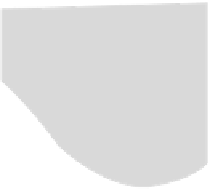Geology Reference
In-Depth Information
Hydrocarbons, however, are poor conductors and cause
an increase in the measured resistivity of a rock relative
to that in which water is the pore fluid. Hydrocarbons
displace pore water and cause it to be reduced to an
irreducible minimum level. Archie (1942) described a
method of estimating the proportion of pore water pre-
sent (the
water saturation S
) based on laboratory measure-
ments of the resistivities of sandstone cores containing
varying proportions of hydrocarbons and pore water of
fixed salinity. If
R
f
and
R
h
are the resistivities of (matrix +
pore water) and (matrix + pore water + hydrocarbons),
respectively, then
formation. Large errors in determining the parameters
from which
k
is derived render permeability the most
difficult reservoir property to estimate.
k
is commonly expressed in darcies, a unit corre-
sponding to a permeability which allows a flow of
1mms
-1
of a fluid of viscosity 10
-3
Pa s through an area of
100 mm
2
under a pressure gradient of 0.1 atm mm
-1
.
Reservoirs commonly exhibit values of permeability
from a few millidarcies to 1 darcy.
11.4.8 Resistivity dipmeter log
The sonde of the
dipmeter log
contains four equally-
spaced microresistivity electrodes at the same horizontal
level, which allow the formation dip and strike to be es-
timated. The orientation of the sonde is determined by
reference to a magnetic compass and its deviation from
the vertical by reference to a spirit level or pendulum.
The four electrodes are mounted at right angles to
each other round the sonde. If the beds are horizontal,
identical readings are obtained at each electrode. Non-
identical readings can be used to determine dip and
strike. In fact the four electrodes can be used to make
four three-point dip calculations as a control on data
quality. Dipmeter results are commonly displayed on
tadpole plots
(Fig. 11.9).
1
n
R
R
=
Ê
Ë
ˆ
¯
f
h
S
(11.6)
where
n
is the
saturation exponent
. The experimentally
determined limits of
n
are 1.5 <
n
< 3.0, although
n
is
usually assumed to be 2 where there is no evidence to the
contrary.
Combining equations (11.4) and (11.6) gives an alter-
native expression for
S
1
n
FR
R
=
Ê
Ë
ˆ
¯
w
h
S
(11.7)
R
f
is determined in parts of the borehole which are
known to be saturated with water.
True dip
Section
20
40
60
80
11.4.7 Permeability estimation
Permeability
(
k
) is a measure of the capacity of a forma-
tion to transmit fluid under the influence of a pressure
gradient. It is dependent upon the degree of intercon-
nection of the pores, the size of the pore throats and the
active capillary forces. It is estimated from the minimum
pore water remaining after displacement of the rest by
hydrocarbons (the
irreducible water saturation S
irr
), which
in turn is estimated from resistivity measurements in
parts of the formation where irreducible saturation
obtains:
2
f
3
c
S
=
Ê
Ë
ˆ
¯
k
(11.8)
irr
where
f
is determined as in Section 11.4.5 and
c
is a con-
stant dependent on the lithology and grain size of the
Fig. 11.9
A typical tadpole plot obtained from a dipmeter log.





























